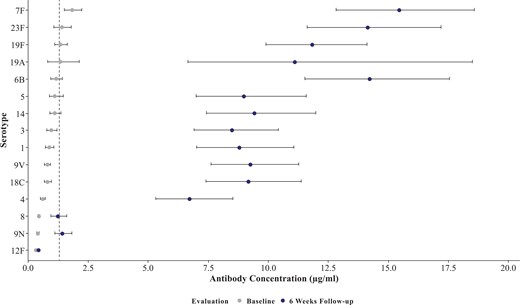-
Views
-
Cite
Cite
Hanadys Ale, Jose G Calderon, Joshua Gruber, Thomas Taylor, William R Blouin, Vivian P Hernández-Trujillo, Pneumococcal serotype-specific antibodies in children with recurrent oto-sinopulmonary infections, Clinical and Experimental Immunology, Volume 219, Issue 1, 2025, uxae086, https://doi.org/10.1093/cei/uxae086
Close - Share Icon Share
Abstract
Low titers to pneumococcal vaccine are a frequent finding in pediatric patients with recurrent oto-sinopulmonary infections. To characterize the pre- and post-immunization antibody trend for each serotype included in the pneumococcal 13-valent conjugate vaccine, in a cohort of pediatric patients with recurrent oto-sinopulmonary infections, this retrospective review identified 182 patients with recurrent oto-sinopulmonary infections (131 required an immune workup and 99 had low pneumococcal titers leading to a pneumococcal 13-valent conjugate vaccine booster). Baseline pneumococcal serotype-specific antibody titers at the initial visit and 6 weeks after the vaccine booster were obtained. An adequate response to the pneumococcal conjugate vaccine was deemed to be a 4-fold increase over baseline and/or a post-immunization titer of 1.3 µg/ml or greater. Overall, The pneumococcal 13-valent conjugate vaccine booster provided a significant improvement in the number of protective titers, increasing from 3.6 serotypes at baseline to 11.1 serotypes at 6 weeks (P < 0.001). This increase correlated with improved clinical outcomes (81% showed no signs of recurrent infection after the first booster and 94% after a second booster). Post-immunization antibody concentrations were significantly higher than at baseline for all serotypes (P < 0.05), and only 8, 9N, and 12F did not exhibit a greater than 4-fold increase (P > 0.05) 6 weeks following booster. There were no differences between patients at different ages in post-immunization titer levels for all serotypes. In pediatric patients with recurrent oto-sinopulmonary infections, an additional pneumococcal booster proved to be effective in the protection of these children against further infections, across all age groups.






